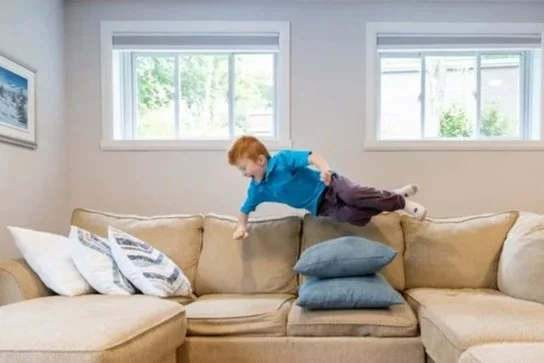In Focus - Sensory Processing Disorder (SPD)
Introduction by Elyse Mandart, M.Ed., CCC-SLP:
As discussed in the blog post “Behavior Is Communication” on 6/30/25, young children often demonstrate “behaviors” as a way of communicating to their caregivers that they are uncomfortable/scared/in pain. However, it can be confusing and frustrating to understand what is trying to be communicated. For example, Landon runs and crashes into the couch, and loves rough and tumble play with his siblings. But, when his peers play soccer at recess, he sits on the side because he says that he is afraid of getting bumped into. Or, Sabrina, a sweet and thoughtful big sister tries to hug her younger brother but squeezes him too hard, or runs into him with excitement and knocks him over. These “behaviors” at first glance seem contradictory. Landon appears to seek out intense touch input, but then is avoiding playing soccer because he doesn’t want to be touched. Sabrina is loving and kind, but then ends up hurting her brother. Below, Mandy Mignone, Occupational Therapist, explains how a Sensory Processing Disorder can create unexpected, and seemingly random or contradictory “behaviors”, but that through therapy and the use of tools, such as a sensory support plan, children can better manage the input from the senses to better regulate their body’s reaction to the world around them.
Sensory Processing Disorder - By Mandy Mignone, OTR/L
Sensory processing disorder (SPD) is a neurological condition that affects how a child’s brain receives and responds to information coming in from the senses. If one of their eight (yes, eight!) sensory systems is out of sync, everyday experiences can feel overwhelming, confusing, or even painful. For many kids with SPD, it can manifest as avoidance, emotional meltdowns, or being in constant motion. It’s almost as if there is a “traffic jam” in the brain and the information from the environment is not effectively being communicated to it. This results in the release of either too many or too few neuro chemicals.
What SPD can look like:
How SPD presents is variable for all individuals. For some, their senses can be heightened, for others their senses are less alert, and for others, their body can have a mix of both more heightened and less aware senses. Some children need and/or crave more input and others avoid it because even a little bit of input is too much for their nervous system to handle. Each child with SPD has their own unique combination. For instance, child A loves to wear clothes that are tight on their skin, like a compression shirt, whereas child B cannot tolerate feeling constricted. And, child A may love swinging high on a swing, whereas child B is afraid to even mount the swing.
It is possible for one child to have a mixed threshold (ie. both sensory seeking AND avoiding). This might look like running and yelling on the loud, busy playground, but when a fire siren goes off, covering their ears and cowering in fear.
Think of your sensory system like a cup. That cup fills with input throughout the day through various types of input coming in from the outside environment. Sizes of the cup can vary. A child with a large sensory cup seemingly cannot get enough sensory input. They can seem like they have infinite energy and tolerate large amounts of input, like being able to swing without getting dizzy. They could also present as a child who struggles with personal space and waiting their turn. A child with a small sensory cup can be uncomfortable with too much input. When their small cup is full, it can result in overwhelm and meltdowns. The sound of a buzzing fluorescent light, a sneeze, or the seam of their sock could be perceived as a threat to their nervous system, resulting in a fight/flight/freeze response which could look like crying, screaming, or running away.
For the children with large sensory cups, they need more input for their bodies to feel organized and regulated. It is important that the input be structured with a final goal in mind.
For the children with small sensory cups, they can benefit from activities throughout their day to help empty their cup so they can better handle additional input. They also need time after the fight/flight/freeze response and need extra time and effort to return to feeling safe.
It is important to view each child’s reactions and behaviors as indicators of the types of input that they seek, avoid, or under respond to, to find patterns. This can be confusing for parents, teachers, and other community members who do not fully grasp the individual's particular sensory profile.
The 8 Sensory Systems And How It Can Manifest With Seeking/Avoiding/Under Responding:
Commonly Known Senses:
1. Auditory - the body’s hearing sense. It gives us information about where sounds are coming from, what they are, and if they should be filtered out.
Seeking - preferring music or the TV very loud
Avoiding - covering ears with certain noises that don’t seem to bother others
Under Respond - not hearing their name being called
2. Visual - the sense of sight. This includes the intensity of the light, the variety, amount and movement of pattern/colors being interpreted.
Seeking - enjoys watching spinning objects
Avoiding - avoiding bright lights
Under Respond - may not pick up on visual cues, like when the teacher darkens the room to grab attention
3. Olfactory- the body’s sense of smell. This sense helps us notice and recognize different scents, their intensity, and can influence taste.
Seeking - smells other people or objects
Avoiding - gags at certain smells
Under Respond - doesn't respond or react to smells, even strong unpleasant odors
4. Gustatory- the body’s sense of taste. This sense is responsible for detecting flavor and its intensity.
Seeking - prefers eating strongly flavored foods
Avoiding - gags while eating, picky eater
Under Respond - doesn't notice certain flavors while eating
5. Tactile- the body’s sense of touch. This sense tells us both when we touch something, and gives us information about what we are touching (is it soft/hard?, bumpy/smooth?, hot/cold?, wet/dry?)
Seeking - constantly needs to fidget or touch
Avoiding - avoids messy play
Under Respond - doesn’t notice when hands/face are dirty
Senses not widely known:
6. Vestibular - the body’s balance system. It is located in the inner ear and tells the brain when it’s moving, spinning, or tilting. It helps us stay upright, coordinate body movements, and feel where our body is in space. Spinning, swinging, and riding in a car give the vestibular system important information.
Seeking - in constant motion
Avoiding - feels uncomfortable with their feet off the ground
Under Respond - being able to spin without feeling dizzy
7. Proprioception - the body’s sense of position, like an internal “GPS” that helps us know where the arms, legs, and rest of our body are without having to look. Messages from the joints and muscles are sent to the brain to relay this information. It helps with things like walking without bumping into others and using the right amount of force when petting a dog.
Seeking - characterized as rough or aggressive
Avoiding - prefers to be sedentary, low energy
Under Respond - slumps in chairs or leans on walls
8. Interoception - the body’s “internal feeling sense.” It helps us notice what is happening inside our body. This sense helps us to recognize signals like when we are hungry, thirsty, tired, or have to use the bathroom.
Seeking - constantly asks for snacks, even when they just ate, in order to feel full
Avoiding - may avoid being active because heavy breathing feels distressing
Under Respond - not recognizing internal signals like having to use the bathroom
Recognizing SPD
Sensory processing disorder can be broken down into three subtypes: Sensory Modulation, Sensory Discrimination, and Sensory-Based Motor. An individual can have a deficit in one or all three of these areas as they work in a hierarchy, or bottom up approach. In Sensory Modulation, children with SPD may engage in seeking, over-responding, or under-responding to sensory input. Furthermore, they can struggle with discerning the information coming in and struggle with posture and motor planning. Sensory processing disorder can occur in isolation, though it is important to note that SPD is not yet categorized as a stand-alone diagnosis by insurance companies and school districts. Most notably, it can occur with autism and ADHD. It can also occur alongside anxiety disorders, learning differences, developmental coordination disorder, and speech and language delays.
Below are some of the ways that SPD might impact everyday activities. Keep in mind, it is important to meet with a professional if you feel as if your child’s sensory responses are making daily life a challenge. Every child has “quirks,” but when sensory differences begin to get in the way of socializing, learning, or independence, that is a sign to look into additional intervention. It would be beneficial to bring a list of your child’s sensory responses to an appointment with your provider.
Hygiene:
Struggling with tasks such as bath time, nail cutting, and hair brushing.
Children can appear fearful to get their hair wet, or refuse a nail trim or brushing of their hair.
Eating:
Difficulty tolerating the texture of certain foods.
Children might refuse to eat foods of various textures or colors.
They may also not notice when their hands or face get messy while eating.
Children might not recognize that their stomach is empty and they are hungry until they are feeling dizzy or sick. They may not understand how much food to consume to feel full. It is important to check in with your pediatrician to ensure your child is getting the nutrition that they require. The idea that “children will eat when they are hungry” does not apply to those with difficulties with sensory processing.
Dressing:
Seams in socks can feel unbearable leading to difficulties with getting dressed.
Children might find tags distracting and painful, and are unable to tolerate clothes that are too tight, or if the fabric is too slippery/noisy.
Sleeping:
Difficulty with settling for sleep and could be described as a “Tasmanian devil” right before bedtime.
Children might also struggle to understand their body’s “tired” signals.
Attention and Focus in school:
Struggling to remain seated in a chair, and distracted by noises in the classroom.
Young children might also struggle to sit on the carpet for circle time without a support to provide stability and/or input for their body in space.
Potty Training:
Not understanding what it feels like internally to have to go to the bathroom
Not feeling stable when seated on a toilet
Avoidance of loud bathrooms
Peer Relationships and Extra Curriculars:
Some children may avoid certain activities with peers or even solo activities due to their struggle with body awareness.
Children may be fearful of unexpected touches playing various sports (ex. getting bumped into on the soccer field), or may struggle with the coordination needed to participate (ex. catching and throwing a ball).
They may come across to their peers/teachers/coaches as “too wild” due to difficulty with grading force.
Struggle with maintaining personal space
Other examples:
The child seems to seek out oral input. This can look like frequent chewing on shirts (often sleeves or collar) or hair. These children often chew holes into shirts from chewing so frequently.
Covering ears and crying when hearing everyday loud noises (for example: the vacuum cleaner, blender)
Crawling into small spaces/behind furniture/under couch cushions to seek input around their bodies
Jumping and crashing (sometimes in unsafe situations) seeking vestibular/proprioceptive/touch input
Crying/covering ears/closing eyes/cowering when in loud busy places because they are overwhelmed (such as a birthday party, a busy indoor gymnasium, a baseball game)
What to do?
If you suspect your child has Sensory Processing Disorder, an occupational therapist (OT) is often the best professional to help. You can start by either asking your pediatrician for a referral, since many insurance companies require one or searching online for “sensory integration occupational therapy near me.” If your child is under age 5, you can reach out to your local early intervention program, or public school district. Private therapy clinics often list OTs who specialize in sensory integration on their websites, and directories like the American Occupational Therapy Association (AOTA) can help you find providers in your area. When reaching out, ask if the OT has specific training in sensory processing and experience working with children, so you know your child will get the right support.
In the meantime, consider coming up with a sensory support plan. A sensory support plan is a personalized set of activities designed to give a child the right kind and amount of sensory input that assists them in staying regulated, calm, and organized throughout their day. It could include jumping on a trampoline, swinging, deep pressure (bear hug), or heavy work (pushing or pulling objects).
It is important to note which types of activities help to calm, what activities your child avoids, and/or what dysregulates your child. It would be helpful to keep notes in an attempt to notice patterns.
Other examples of activities you might see in a sensory support plan include:
Pushing a laundry basket filled with weighted items
Carrying in groceries or trash cans
Crawling through tunnels
Jumping on a trampoline while listening to a song
Fidget toys
Offering opportunities for crunchy, chewy snacks or a chew necklace
Offering a quiet, cozy space in the house your child could go to for a break
Keep in mind that even children who are seeking input can become overwhelmed. It's a tricky balance to give them what their body needs without going overboard. That's why seeing an occupational therapist is so important—they can help families figure out the best ways to support their child.
Behavior Decoder - how YOU can support your child feeling regulated in each of the senses:
1. Auditory - the body’s hearing sense.
Seeking - play music in the background
Avoiding - tennis balls on the bottom of chairs in classroom to reduce noise; noise reduction headphones
2. Visual - the body’s sense of sight.
Seeking - light up wands, glitter sensory tubes
Avoiding - wearing sunglasses even indoors
3. Olfactory- the body’s sense of smell.
Seeking - use of smelly markers during art
Avoiding - preferential seating in cafeteria to limit smells
4. Gustatory- the body’s sense of taste.
Seeking - offer extra spices with food
Avoiding - offering “safe” foods
5. Tactile- the body’s sense of touch.
Seeking - offer breaks with sensory bins (i.e. bins with kinetic sand, dried rice, dried beans, or dried pasta to manipulate with their hands and add toys for an extra layer of fun)
Avoiding - allow child to mix with spoon instead of having to touch the material with their hands
6. Vestibular - the body’s balance system. It is located in the inner ear and tells the brain when it’s moving, spinning, or tilting.
Seeking - neck rolls or spins as a movement break
Avoiding - following child’s lead when trying something new, never forcing
7. Proprioception - the body’s sense of position, like an internal “GPS” that helps us know where the arms, legs, and rest of our body are without having to look.
Seeking - offering opportunities for “heavy work” (ie. pushing heavy objects and in an effort to provide feedback to their joints/muscles)
Avoiding - start small with gentle, controlled movements of the body
8. Interoception - the body’s “internal feeling sense.” It helps us notice what is happening inside our body.
Seeking - offer scheduled snack times
Avoiding - modeling talk of your own body cues, for example, “My stomach is growling, I must be hungry and should eat to take care of my body.”
It is important to note that each child is different. What is regulating for one, could dysregulate another. If applicable, always be sure to consult with your occupational therapist to ensure your child is getting the right type of support.
What to expect in an OT evaluation?
Depending on your child's age, the setting, and reason for referral an occupational therapy evaluation can vary. Generally, here is what you can expect:
Collecting background information - medical history, developmental milestones, daily routines, concerns, parent report of types of seeking/avoiding behaviors (it is helpful to write them down and make a list)
Standardized testing - fine motor, sensory processing, visual-motor, gross motor, feeding
Clinical observation - observing skills such as: sensory seeking and/or avoidance, play, writing, coloring, motor planning, attention
Hands-On activities - engaging the child in climbing, puzzles, balance games, body awareness games
At the end of the evaluation the occupational therapist will share their impressions and if therapy is needed, make suggestions accordingly. Common treatment techniques for SPD include: “heavy work” through obstacle courses, fine motor games, activities that have sensory components individualized to your child (could include brushing, swinging, or fidgets), environmental modification, sensory diet, and development of coping strategies.
Sensory Processing Disorders are a real and important area of practice and the science continues to evolve and expand. Occupational therapists have been involved in this work for decades, developing effective, research based interventions that assist kids with developing their full potential. Children with SPD can make wonderful progress with understanding, patience, and the right support. As your child learns what their body needs, they will learn to navigate their world with ease and confidence.
Check out these resources for additional support:
Websites:
Cleveland Clinic: Sensory Processing Disorder (SPD)
Children’s Hospital of Philadelphia (CHOP) Research Institute: Sensory Processing and Sensory Integration in Individuals with ASD
Child Mind Institute: Sensory Processing Issues Explained
Sensory Smarts: Sensory Diet Activties
Autism Awareness Centre Inc.: What is a Sensory Diet?
Healthline: How a Sensory Diet Can Help Your Child
Books: As an Amazon Associate, “I Can Do This LLC” earns a small percentage from qualifying purchases.








